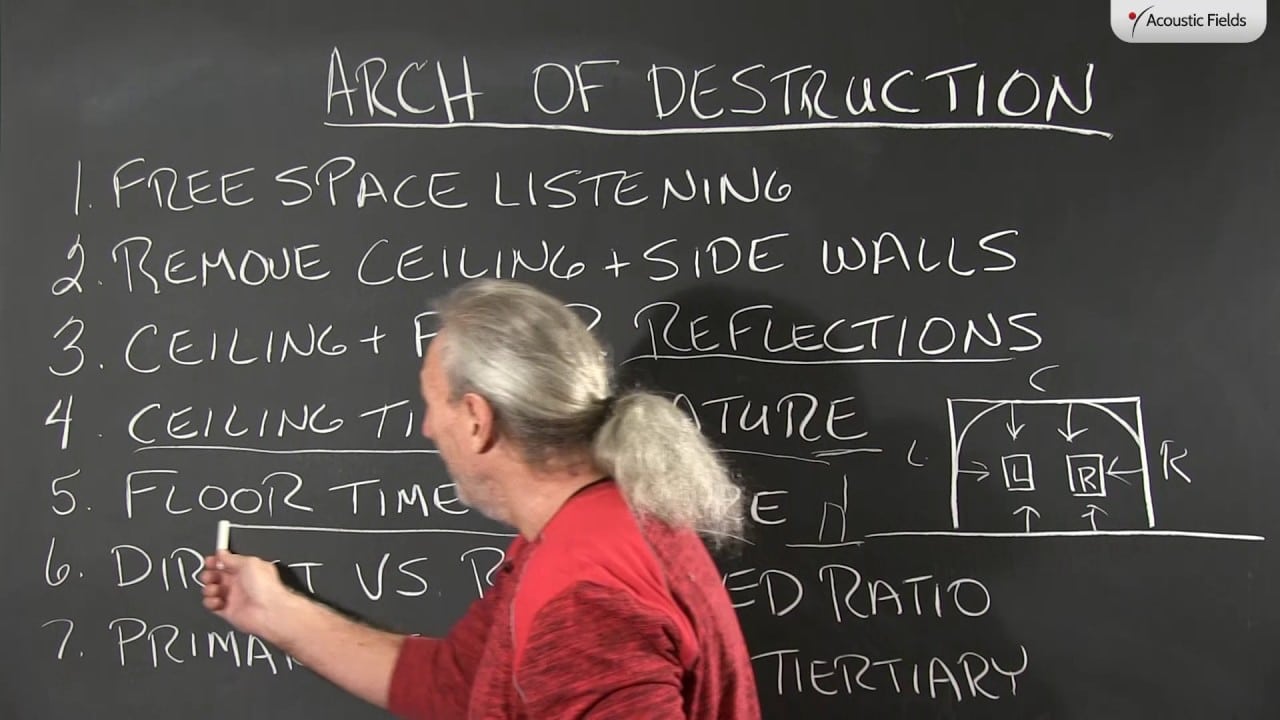Let’s talk about the Arch of Destruction, kind of a fancy name but I think you’ll see as we walk through some examples how important the side walls and the ceiling are to this situation. So the most ideal situation we can have in listening to two channeled music whether it’s monitoring and a mixing mastering position or anything else that deals with two channels is to listen in free space.
Well free space means no rooms, no boundaries, no walls no floors – got to have floors I guess – no ceilings, so no walls and no ceiling. So if we take our system outside and we listen to it without boundaries, we get a certain sound quality, we listen to it inside with room boundaries then we have all kinds of issues thus the name Arch of Destruction which refers to our left side wall, our right side wall and our ceiling so it kind of forms an arch.
So we have all of the issues now dealing with the ceiling and the two side walls and a lot of people don’t really understand this so we’re going to walk through some examples. So we walked through removing the ceiling and the side walls and how we’re going to get a different sound quality and what’s the tributes to all that? It’s all about reflections, it’s all about reflections and the time signature of those reflections from the side walls, from our left side wall, from our right side wall, from our ceiling we have all of these reflections inter playing upon what we’re doing, floor also. All of these contribute to a certain sound quality so we have to really work with the time signature of all of these reflections and the ceiling to the floor is one of the most critical because we’re sitting in our chair on the floor so that boundary surface is critical and then the ceiling is the next closest distance above the chair so we have that to deal with.
So we have floor and time signature, it’s always a balance between the direct sound from our loudspeakers and the reflected energy from the room so we always have this balance to achieve. So the treatments that we use to get this balance is critical, the rates and levels of absorption and I see this all the time, one size does not fit all, just because it’s the sound absorbing material does not mean it’s right in its application on your side wall. It depends on distance, usage, driver size distance to listening position, lots of variables to consider so balancing the direct versus the reflected energy is very critical. What kind of reflections do we have from our side walls?
We have the primary which is this reflection here to the speaker off the closest boundary surface then that reflection travels across to the other wall, that’s our secondary and then that reflection travels back to its original wall so we have all of these reflections going on, we have all of these balancing acts that we have to produce to balance all of these reflections with the direct sound from our speakers. So there we have it, we call it the Arch of Destruction, it’s the side walls and ceiling and you really have to take special care in the treatment that you use to manage the balance between the direct and the reflected energy.
—
This is an unedited transcript from our video series from Acoustic Fields. There will be some errors in grammar and sentence structure that occur during this translation process.
For complete understanding and comprehension, please view the video which is included in this text. For any additional information regarding this topic or others relating to room acoustics, please contact us directly at:
P: 520 – 392 – 9486







